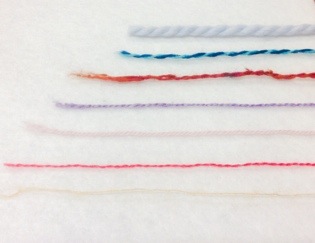Looking for instructions on working a gauge swatch? See Getting Good with Gauge here. Learn how designers use gauge swatches in patterns here.
Yarn Gauge
Along with helping knitters to match a designer's measurements, gauge is also used to classify yarns into weight categories. These categories are based on the stitch counts found within a 10cm/4" square, when the square is worked in stockinette stitch to make an opaque but not stiff fabric.
The weight categories most commonly used in North America are these:
Laceweight: 32-34 stitches
Fingering (aka sockweight): 28-32 stitches
Sportweight: 24-26 stitches
DK: 20-22 stitches
Worsted: 18-20 stitches
Aran: 16-18 stitches
Chunky: 14-16 stitches
Bulky: 12-14 stitches
Super Bulky: 8-12 stitches
The Craft Yarn Council of America has created broader categories, numbered 1-6 like this:
0: Lace, 33-40 stitches and higher
1: Super Fine, 27-32 stitches
2: Fine, 23-26 stitches
3: Light, 21-24 stitches
4: Medium, 16-20 stitches
5: Bulky, 12-15 stitches
6: Super Bulky, 6-11 stitches
We use these categories to help narrow down the options when we need to recommend a substitute yarn for a pattern. Gauge is the first thing we look at, and then fibre content (cotton and linen yarns behave very differently from wool yarns, as do silk and camelid fibres ), and then finally yarn construction - a yarn that is tightly spun for durability won't substitute well for an airy, lofty yarn, and vice versa!


